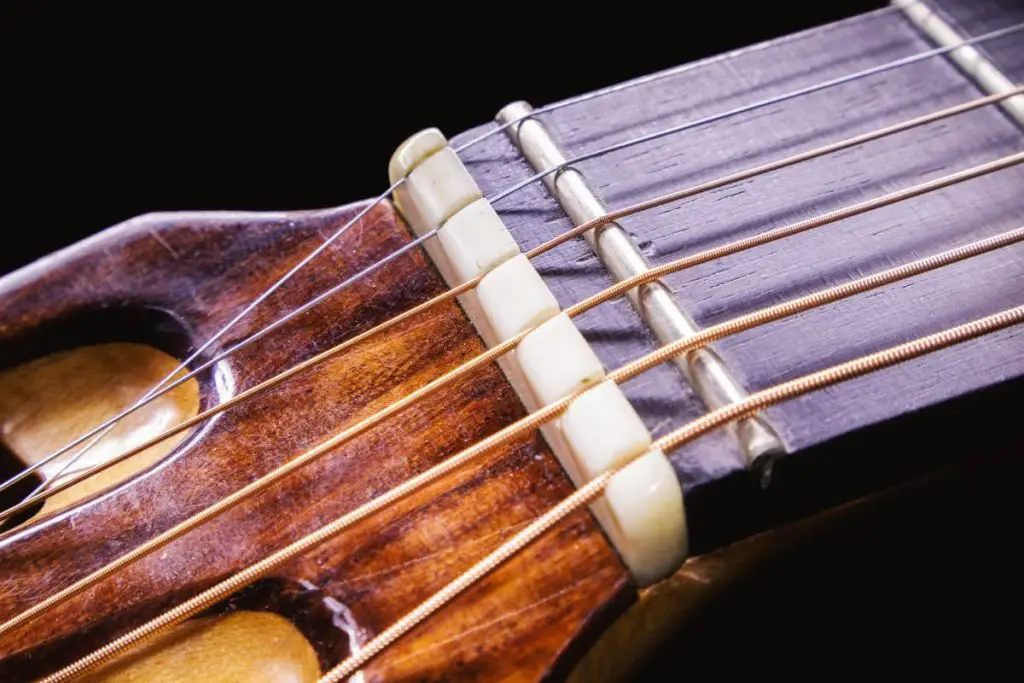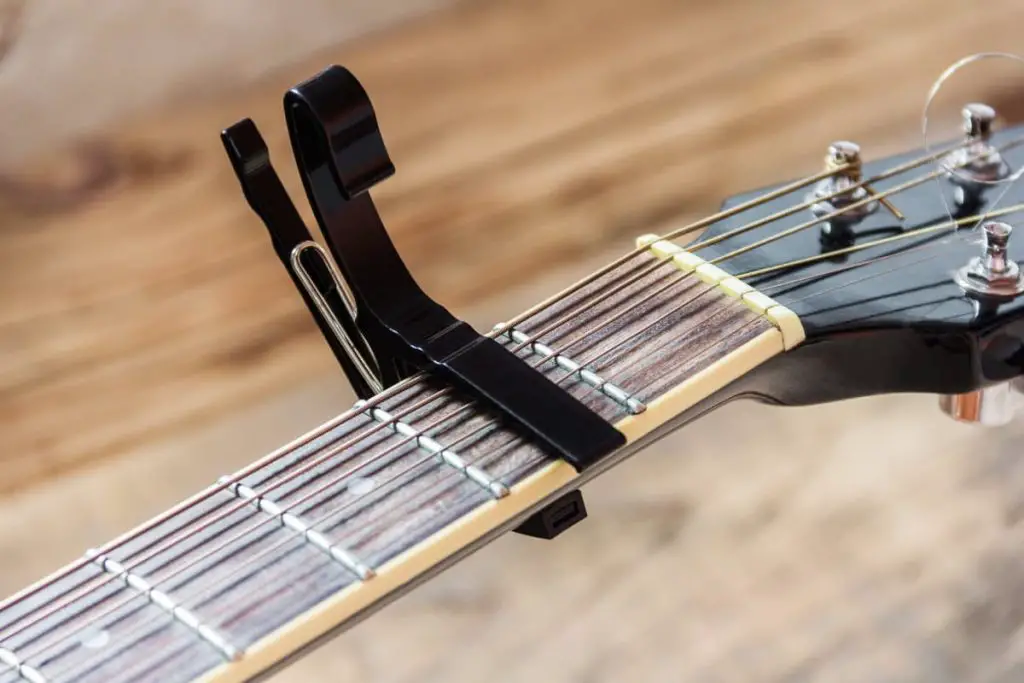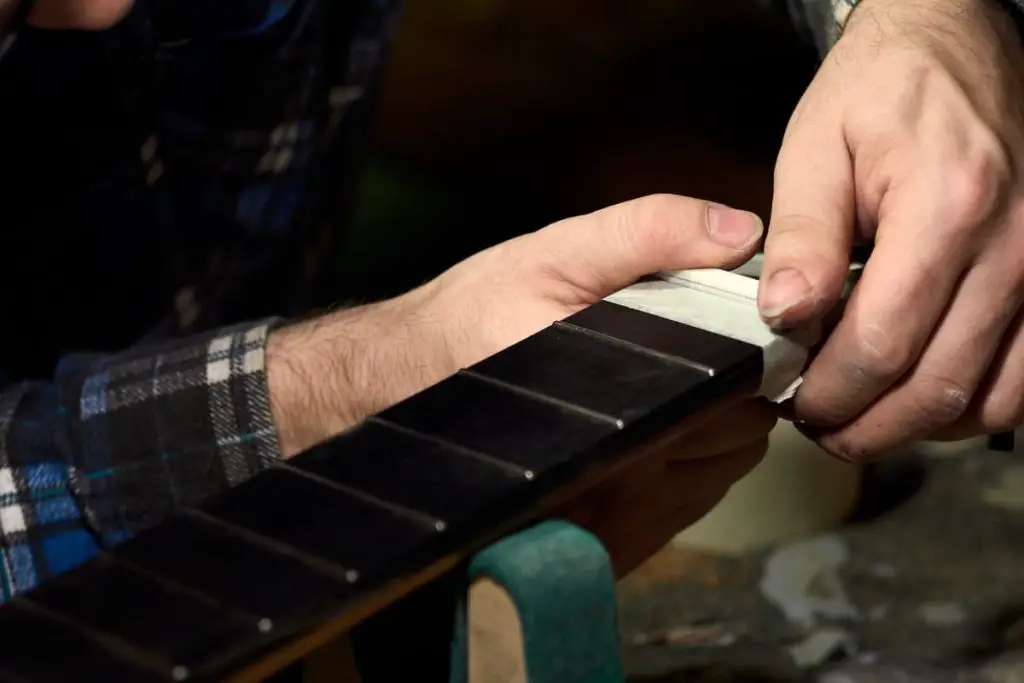Your guitar nut is a vital part of your guitar, and if it is too high, your guitar just won’t sound right. Ensuring that your guitar nut is the perfect height is essential for high-quality sound. However, you might not know the signs to look out for if you suspect your guitar nut may be too high.
Here are six signs that your guitar nut is too high:
- The tone of your guitar sounds wrong.
- Your guitar is difficult to play.
- You struggle to tune your guitar.
- Your strings are high-action.
- Some notes are sharp.
- Your guitar is easier to play when using a capo.
Let’s take a closer look at these six signs so that you know what to look out for and how to fix the problem if it arises.
If you want to find out what my recommended guitar gear is, then here is what I recommend on Amazon:
- Fender Cutaway Acoustic-Electric Guitar Bundle (MY FAVORITE GUITAR)
- Snark SN-8 Super Tight All Instrument Tuner (Easiest Tuner I’ve Used)
- 6 String Acoustic Guitar Capo (Best CAPO for quick changes)
- Dunlop Max Grip 1.0mm Nylon Picks (Thick Guitar Pick So You Don’t Lose Grip!)
- Universal Guitar Stand (Cheap & Minimalist Guitar Stand I Recommend)
- Levy’s 2″ Wide Quick Adjust Guitar Strap (Best Guitar Strap For Any Level)

1. The Tone of Your Guitar Sounds Wrong
The guitar nut is an essential component of your guitar. If you are a novice, you might not be aware of this fact as the nut is such a small part. The strings of your guitar run from the tuning pegs through a slot in the nut, down the neck, and to the bridge.
Each string runs through a slot carved into the nut. If the nut is too high, it can affect the sound of your guitar. If the guitar nut is high, there will be a bigger space between the strings and the fret, whereas there will only be minimal space if the nut is low.
Nuts can be made from different materials, which can also cause the sound of your guitar to differ. So, if you decide to replace the nut on your guitar–especially for one made from a different material–don’t be surprised if it sounds a little different.
Changing the nut will, however, not cause the tone to sound wrong. If the overall sound of your guitar sounds wrong when you play it, check to see if your strings are sitting too high. Remember, it is the vibrations from the strings that run through the wood of the guitar that causes the sound output, and if the action is too high, it won’t sound right.
2. Your Guitar Is Difficult To Play
If your guitar nut is too high, it can be extremely uncomfortable to play your guitar. You will have to press down harder on the string because it is further away from the fret, and this can cause your fingers to hurt more than usual.
However, there are many reasons why your guitar can be challenging to play. So, if you are struggling to play and your fingers are aching, you may want to take a look at your guitar nut. A faulty guitar nut can even cause your guitar to rattle when you are playing it.
The guitar nut can cause an array of problems if it isn’t the correct height. Sometimes, the slots might even be too sharp and cause your strings to break. This doesn’t mean that the nut is too high, but if your strings are breaking for no apparent reason, you should have a look at your guitar nut.

3. You Struggle To Tune Your Guitar
When your nut is too high, it can be difficult to tune your guitar correctly. The slots in the nut anchor the strings in place. So, if they sit too high, it can be difficult to tune your guitar.
If the nut is exceptionally high, meaning one or more of the slots haven’t been carved out to perfection, it is even possible for your string to jump out of the slot. Two-thirds of the string must fit inside the nut and one-third above it for a perfect fit.
When tuning your guitar, listen to the sound of each string, as only one or more of the strings may be sitting too high. If the string makes a pinging sound when tuning it, look at your nut as it could be too high.
4. Your Strings Are High Action
When your guitar nut is too high, your strings will be high action. This means there will be too much space between the strings and the frets. As discussed above, this can make playing the guitar difficult and hurt your fingers.
For the untrained eye, it might not be easy to see if your strings are sitting too high, but once you know what they look like when perfectly fitted, you should be able to see it.
High action is mainly the result of slots in the nut being carved too shallow. It is, however, possible that the slots are fine, and there is excess glue under the nut, causing it to sit higher.
If you are unsure whether your action is too high, there are ways to measure it. You will, however, need one of these items:
- Ruler
- Feeler gauge
- String action gauge
When using a ruler, ensure that it has a straight end and that the measurements start right from the beginning, or you will not get an accurate measurement.
A string action gauge like this BIGTEDDY String Action Ruler (available on Amazon.com) is the perfect tool to measure your string action. It is small enough to keep in your guitar repair kit and is multi-use as it has measurements on one side and a conversion chart of string action on the other. This string action ruler gauge will help you accurately measure your string height so that you never have to struggle with high action strings again.
You can measure your string height at any fret, but it is usually recommended to measure it at the 12th fret for the best accuracy. Many guitarists prefer to play with slightly high or slightly low action, but good standard string action heights are as follows:
- Acoustic guitar. On low E, your action should be 7/64” (2.8mm), and on high E, it should be 5/64” (2mm).
- Electric guitar. On low E, your action should be 6/64” (2.4mm), and on high E, it should be 4/64” (1.6mm).
The above heights are for measuring your strings at the 12th fret, as this is the position most often used.
Many slide players intentionally use high action on their guitars, making playing with a slide much easier. You shouldn’t touch the frets when playing with a slide, so it is understandable that they might prefer playing on a high-action guitar.
For any other guitarist, medium action is the best.
Low-action strings are easier to play, so you will be able to play faster. This might seem like a good idea, and if you can strum gently, it will be fine. But, if you are an aggressive strummer, it will be a problem as you will experience a lot of guitar buzz with low-action strings.
Guitar Nuts Can Be Too Low, Too Tight, and Too Wide
For this article, we will be focusing on guitar nuts that are too high, but it is also important that you know that your guitar nut can be too low, too tight, and too wide as well. If your guitar nut is not right, you will experience many different problems, so it is best to ensure that your guitar nut is right and your action is perfect.

Your Guitar Nut Is Too Low
A guitar nut that is too low can cause your strings to buzz, which sounds horrible and can be embarrassing if you are playing in front of a crowd.
When buying a new guitar or replacing your guitar nut, you should ensure that the slots in the nut aren’t cut too low. If the slot is too low, there isn’t much you can do about it, unfortunately. Raising a guitar nut is not easy and filling up the slot isn’t a good idea. If the slots are too low, your best option is to replace the nut.
It is also possible for the slots in the guitar nut to wear out over time. If this is the situation, it is also best to replace the nut. Guitar nuts come in a variety of different materials, such as:
The material your guitar nut is made from will affect the sound of your guitar. Nuts made from dense material usually sound better and last longer.
You can get these Vencetmat Unbleached Acoustic Guitar Nuts (available on Amazon.com) to replace your worn-out guitar nut. These guitar nuts are made from bone, which is arguably the best guitar nut material. You will also get a pack of four, so you can replace your guitar nut if ever it wears out again. They also look super cool and will enhance the look of any guitar.
Your Guitar Nut Is Too Tight
Figuring out that your guitar nut slot is too tight isn’t as bad as when it is too low or too wide. If your guitar string gets stuck in the slot when you are restringing your guitar, or the string makes an odd sound when tuning, the slot might be too tight.
You can fix a nut slot that is too tight by filing it slightly. You should be careful while doing this as you can easily file off too much material and make it too wide, which is a much bigger problem.
Your Guitar Nut Is Too Wide
If your guitar nut slot is too wide, the guitar string will move around in the slot. This can affect the sound of your guitar as well as the sustain. It will also make it difficult to tune your guitar and for it to stay in tune.
A guitar nut slot that is too wide can’t be fixed, so it is best to invest in a new one.
5. Some Notes Are Sharp
When your nut is too high, you will notice that some of the notes you play sound way too sharp, especially in the first few positions. This isn’t the easiest way to determine whether your nut is too high, but an experienced guitarist will be able to hear that there is something wrong immediately.
The notes on the lower frets might not sound sharp, but if the notes from fret 1 to 3 sound sharper than they should, your nut might be too high.
6. Your Guitar Is Easier To Play When Using a Capo
If you own a capo and think your nut might be too high, here is an easy experiment for you. Play a song that you feel comfortable with, and take note of the following things:
- How do the strings feel on your fingers when you press down on the frets?
- Does it hurt your fingers when you play?
- Do any of the notes sound sharp?
- Does the tone of your guitar sound wrong?
- Is it comfortable to play?
Now, place your capo on the neck of your guitar, between the nut and the first fret. The capo works like a clamp and essentially acts as a new nut. Once your capo is in place, play the song again. If playing your guitar with the capo on is easier, your nut might be too high. A capo presses the strings down, meaning it changes your string action.

How To Fix a Guitar Nut That Is Too High
The easiest way to fix a guitar nut that is too high is to replace it. You can buy a new nut and replace it yourself or take it to a luthier or your local guitar shop to be done for you.
You can also try adjusting the height of the guitar nut slot by filing it, but this is an intricate job and should only be done if you are sure you are capable. If you mess it up, you must replace the entire nut. A luthier will be able to file your nut to the correct height if you want to err on the side of caution.
If you decide to replace the entire nut, you can follow these steps:
- Remove the strings and place them somewhere safe if you plan on using them again.
- Place your guitar on a sturdy bench.
- Ensure that the neck of your guitar is supported.
- If the nut isn’t glued to the head, you can simply remove it.
- If the nut is held in place with glue, you will now have to remove the glue. You can use a sharp knife to loosen the nut from the head carefully, or you can also use heat to loosen the glue and then remove the nut.
- Once you have removed the nut, you should clean the guitar and remove all residue.
- Ensure your guitar nut is the correct size before sticking it down. You do not want to have to remove the nut again just to file down the bottom because it is sitting too high.
- Fit the new guitar nut on your guitar.
- Restring your guitar and make sure that the strings are at the right action using a feeler gauge.
If replacing the nut because it is too high sounds unnecessary, there is always the option of filing the slots.
You will need the correct nut files like this BIGTEDDY Guitar Fret File Set (available on Amazon.com). The set includes flat, square, round, oval, triangle, and warding files, meaning you can easily shape and carve the nut slot perfectly. They will speed up the job at hand and leave you with a smooth slot that will perfectly fit your string.
Before filing the nut slots, ensure there are no problems with the bridge and that the truss rod is set up correctly. Filling the nut of your guitar is a delicate job and you need to know what you are doing before proceeding.
Do not remove your strings to file the slots. Be careful and work slowly, making sure you use the correct size file for the strings you are using.
While filing, you need to constantly check the height of the string as you do not want to remove too much material and be left with a low-action guitar. To check the action of your string, you can use a feeler gauge.

You can get this Hotop 32-Blade Practical Steel Feeler Gauge Gap Measuring Tool (available on Amazon.com) to make sure you file your nut slots perfectly. These feeler gauges come in various sizes, so you can use them on all your guitars regardless of the action, and they are made from manganese steel, so they are strong and durable.
Here is an informative YouTube video showing you how to file a guitar nut to get the correct string action.
Final Thoughts
Figuring out whether your guitar nut is too high might sound complicated, but it does have to be. Remember the above six signs, and make sure to check your guitar for any problems routinely.
If you love your guitar, you should already have a decent maintenance schedule, so look out for the above sign when you do your next check, and if it turns out that your guitar neck is too high. With the right amount of patience, you can file the nut slot to the correct height and your guitar will sound better than ever.
If you want to find out what my recommended guitar gear is, then here is what I recommend on Amazon:
- Fender Cutaway Acoustic-Electric Guitar Bundle (MY FAVORITE GUITAR)
- Snark SN-8 Super Tight All Instrument Tuner (Easiest Tuner I’ve Used)
- 6 String Acoustic Guitar Capo (Best CAPO for quick changes)
- Dunlop Max Grip 1.0mm Nylon Picks (Thick Guitar Pick So You Don’t Lose Grip!)
- Universal Guitar Stand (Cheap & Minimalist Guitar Stand I Recommend)
- Levy’s 2″ Wide Quick Adjust Guitar Strap (Best Guitar Strap For Any Level)
Related Posts:

